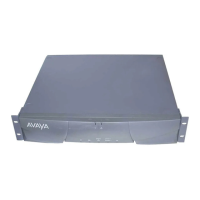Isolating and Repairing Packet-Bus Faults
Issue 1 May 2002
4-103555-233-143
h. If work is being done on-site, follow the procedures described earlier in this
discussion on stand-alone mode. If work is not being done on-site, go to
the next step.
i. The answer is “yes” if any of the following apply:
■ The TN771D in stand-alone mode indicates any faulty leads.
■ Test #572 in the PKT-BUS test sequence fails.
■ The status port-network P display indicates that faulty leads are
present, and the TN771D in the port network is known to be
functioning correctly.
j. If the non-functional endpoints are isolated to a single circuit pack, then
that circuit pack is probably the cause of the problem.
k. Investigate errors and alarms in the following order:
1. Circuit-pack level
2. Ports
3. Endpoints
l. Follow the ‘‘Troubleshooting Procedures’’ on page 4-105. If the packet-bus
problem cannot be resolved with these procedures, follow normal
escalation procedures.
Correcting Packet-Bus Faults
Status Port-Network Command
Status port-network P displays include the service state, alarm status, and (if the
Maintenance/Test packet-bus port is present) the number of faulty and open leads
for the specified port network’s packet bus. This information can be used to
determine the urgency of the repair. In general, a service state of “out” indicates
extreme urgency, while a service state of “reconfig” indicates moderate urgency.
NOTE:
Ultimately, the urgency of a repair is determined by the customer’s
requirements. A customer who uses ISDN BRI for station sets, or who relies
heavily on packet-bus supported system-adjunct features (like DCS, AUDIX,
or CDR) probably considers a packet-bus fault critical. On the other hand, a
customer with little ISDN-BRI service and no adjunct features may consider
even an uncorrectable packet-bus fault less important, and may prefer to
delay repairs due to their disruptive nature.
If background maintenance is running on the packet bus when the status
port-network command is issued, the data reported for the packet bus may be
inconsistent due to updating by the tests. If the data seems inconsistent, enter
the command again.

